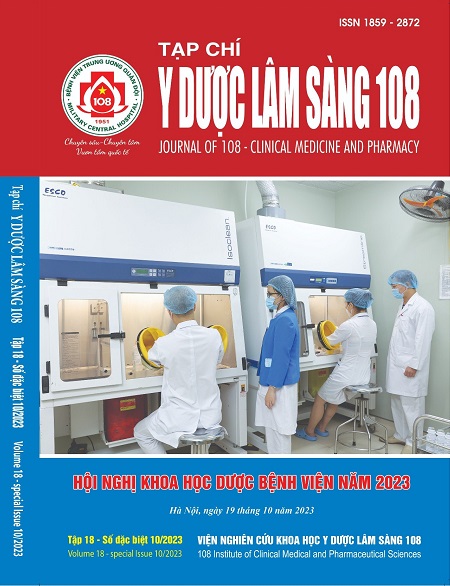Antibiotic resistance characteristics and factors related to treatment outcomes in patients with nosocomial infections at Vinh Phuc Hospital's intensive care unit
Main Article Content
Keywords
Abstract
Objective: To determine antibiotic resistance rates of common bacteria causing nosocomial infections and some factors related to clinical outcomes and treatment at Department of Intensive Care, Vinh Phuc province Hospital. Subject and method: This was a prospective, cross-sectional study on 76 patients diagnosed with nosocomial infections at the Intensive Care Unit (ICU) of Vinh Phuc Province Hospital from January to September 2021. Result: The main pathogens was A. baumannii (34.4%), P. aeruginosa (18.8%) and K. pneumoniae (15.6%) with antibiotic resistanced rates with cephalosporins, quinolones, aminoglycosides, carbapenem from 50%-100% and lower resistanced to colistin group (11.1%-33%). Patients with nosocomial infections had a high mortality rate (56.6%), a high rate of septic shock (43.4%) and a long duration of treatment (18 ± 9 days). Factors associated with mortality and risk of septic shock were patients with pre-existing medical conditions, medication in the past 30 days, invasive procedures, and inappropriate empiric antibiotic therapy. Conclusion: The most common pathogens in nosocomial infections was multi-antibiotic resistant bacteria. Patients with underlying medical conditions, procedural interventions and empiric antibiotic therapy was factors related to patient outcomes.
Article Details
References
2. Hsueh PR, Chen WH, Luh KT (2010) Relationships between antimicrobial use and antimicrobial resistance in Gram-negative bacteria causing nosocomial infections from 1996-2008 at a university hospital in Taiwan. International Journal of Antimicrobial Agents 26: 463-472. doi: 10.1016/j.ijantimicag.2010.08.016.
3. Alfouzan W, Dhar R, Abdo NM, Alali WQ, Rabaan AA (2021) Epidemiology and microbiological profile of common healthcare associated infections among patients in the Intensive Care Unit of a General Hospital in Kuwait: A Retrospective Observational Study. Journal of Epidemiology and Global Health Vol. 11(3): 302-309 DOI: https://doi.org/10.2991 /jegh.k.210524.001; ISSN 2210-6006.
4. Otero ML, Menezes RC, Ferreira IBB, Issa FL, Agareno G, Carmo TA, Arriaga MB, Fukutani KF, Pamplona Neto L, Agareno S, Filgueiras Filho NM, Akrami KM, Andrade BB (2020) Factors Associated with Mortality in Critically Ill Patients Diagnosed with Hospital Acquired Infections. Infection and Drug Resistance 2020:13 2811-2817.
5. Duong Bich Thuy, James Campbell, Le Thanh Hoang Nhat (2018) Hospital-acquired colonization and infections in a Vietnamese intensive care unit. PLOS ONE. https://doi.org/10.1371/journal. pone.0203600.
6. CDC (2019) HAI Data and Statistics. CDC's National Healthcare Safety Network (NHSN).
7. Etemad M, Khani Y, Hashemi-Nazari SS et al (2021) Survival rate in patients with ICU-acquired infections and its related factors in Iran’s hospitals. Etemad et al. BMC Public Health 21: 787.https://doi.org/10.1186/s12889-021-10857-y.
8. Despotovic A, Milosevic B, Milosevic I, Mitrovic N, Cirkovic A, Jovanovic S, Stevanovic G (2020) Hospital-acquired infections in the adult intensive care unit Epidemiology, antimicrobial resistance patterns, and risk factors for acquisition and mortality. American Journal of Infection Control 48: 1211-1215. https://doi.org/10.1016/j.ajic.2020.01.009.
9. Aydogdu M, Gursel G (2010) Predictive Factors for Septic Shock in Patients with Ventilator-Associated Pneumonia. Southern Medical Journal. 101.12.2010.
 ISSN: 1859 - 2872
ISSN: 1859 - 2872
